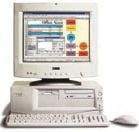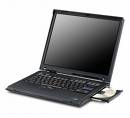Buyers Guide to Desktop PCs: Choosing the best home and office desktop PCs
> Desktop PCs

Choice is, as many consumers will ultimately admit, a double-edged sword. Many of us crave it, but we also want our purchasing decisions to be relatively straightforward. The
PC market, particularly in recent years, has splintered into lots of different segments, each of which offers varying and interesting options. This following guide should make things that little bit simpler for the novice PC buyer, whether for enterprise, business or the home.
Bear in mind that the individual components mentioned here will change rapidly (e.g. graphics cards,
hard drive sizes and processor speeds), but the general points remain the same.
How to find the best office and home desktop PCs

A PC for the office (home or work) actually needs few frills to it. That's because one by-product of technological advances and price drops of the past ten years is that a budget PC can easily do the majority of things asked of it. Save for playing 3D games, video editing and intense multimedia work, a mere £400 can return a capable machine.
For that kind of money, you're looking (at the time of writing) at a processor along the lines of a Sempron 2400 from AMD, an Athlon XP 3200+, maybe even a lower-end Athlon 64 chip. If you prefer
Intel, your machine is likely to pack a Pentium 4 2.6GHz or faster. That's ample processing power for any office tasks, for DVD playback and for anything Internet related.
In this price bracket, you're more likely to get a CRT screen as opposed to a snazzy looking thin TFT, and you'll be doing well to get
512MB of RAM (256MB should be your absolute minimum). A 60GB hard drive, a CD burner and bog-standard speakers, keyboard and mouse will round the package out.
Where the economies are made for the manufacturer is in the graphics department. They assume you won't want to play 3D games, so rarely give you a graphics card that can handle anything too modern. For many, that won't be a problem, but it's best to know this before you hand over your money.
Incidentally, pretty much all PCs now come with a built-in modem, USB 2.0 ports, an on-board sound device and networking features.

This applies to even the really cheap ones, but be sure to check first if these items are really important to you.
A PC for a family, on the other hand, by its very nature has to please a lot of people. It's generally a compromise system of sorts that can handle limited 3D gaming (although there's a strong argument that a games console would be a thriftier long term investment), the majority of multimedia tasks and everything else the budget workhorse machine can handle.
We're looking in the £500-£600 price bracket here, and for that you should expect a 3GHz+ processor, a DVD writer, a TFT screen (probably around 17-inch) and 512MB of RAM. A 120GB hard disk should be standard for this kind of money too, and you'll find out how valuable that space is when you start dabbling with video editing, MP3s and movie trailer downloads!
You'll also get a good, reliable graphics card, possibly based on the PCI-Express standard. The kind of graphics power you get for this budget (at the time of writing) is around the GeForce 6600GT or Radeon X700 level, either of which will happily deal with modern 3D games for around a year or so. You should also get a reasonable bundle of software, encompassing an
operating system (which, along with a screen, is occasionally omitted from budget PC advertising to make the package look cheaper than it actually is), an anti-virus package, DVD playback software and possibly some office software too.
One growth area in
desktop PCs has been the specifically targeted home entertainment machine. These computers can play all sorts of media without you having to go through an elongated switch on and boot up procedure. However, in our view, they're still something of a false economy. You can pay anywhere near £1,000, which usually gets you a machine with a nice screen, fancy software but limited functionality beyond home entertainment (certainly gaming seems to be a no-no).

If you do go down this route, though, you can expect to get a special version of Windows XP entitled Media Center Edition with your machine, and it will be easy enough to use.
The real money is spent on gaming systems. PC gamers tend to be more dedicated than their console counterparts, and that's because PC games tend to require a bigger investment of both time and cash. On the latter point, you can pay a premium of some £300-£400 to put a high-end graphics card into the home PC specification we outlined earlier, and chances are that would be for technology that games won't even fully utilise for a year or two.
Still, performance PCs aren't just about the graphics card, and that's why the price of such a system tends to hover around the £1,000 mark. For that, you get branded and premium components, particularly when it comes to the likes of memory. You can expect a serial ATA hard drive of anywhere up to 250GB or more in capacity, and a bare minimum of 512MB of RAM (usually 1GB though).
Your case will look like it's just stepped out of a design shop (and be wary of falling for looks - a snazzy case doesn't always play host to a decent computer), you'll be blessed with hefty speakers, a super-sharp TFT screen (19-inch minimum) and quality peripherals. You'll also get a top notch processor, an Athlon 64 3800 for instance, or a Pentium 4 3.6GHz.
And yet it's still possible to get more. In 2004, AMD and Intel launched top of the range versions of their home processors. Intel had the Extreme Edition Pentium 4, whilst AMD launched the Athlon 64 FX53 and subsequently the FX55. Both firms designed these processors for the money-is-no-object customer, and perhaps it goes without saying that you pay a hefty premium, and these don't deliver the best value performance to the pound. Nonetheless, for the best part of £2,000, many firms will sell you a PC incorporating one of these, along with similarly top-of-the-line components.
In this price bracket, frankly you're getting the works. An ATI X800 or NVidia GeForce 6800 Ultra graphics card as bare minimum. Perhaps a top of the range Audigy 2 sound card. A posh TFT screen, up to 21-inch in size.

1GB or 2GB of performance RAM. Storage well in excess of 300GB. Getting the picture?
One caveat if you're planning to go down this road. Much as with buying a new car, your PC drops in value quickly, and while it may not be true to say it's outdated the second you buy it, nonetheless you don't have long to wait for the next must-have advance. Still, if you've got the cash and really want to spend it...
Hopefully, that's given you a broad overview of what your cash can get you, all up to date at the time of writing but, as we've said, the details are subject to rapid change. Here are a few more tips to be wary of:
- Free bundled scanners and
printers are the epitome of false economies in almost all cases. You can't expect great performance, cheap printers guzzle ink like there's no tomorrow, and in fact it's better if you budget for whichever device you need and choose it properly.
- Tricks firms use to keep the costs down on their prices: not including a monitor, not including an operating system, not including VAT in the prices and not including delivery and/or credit card surcharges. Check all these out in advance.
- Don't be fooled by aesthetics. A bog-standard PC in a nice case will always be the poorer cousin of the nice PC in the bog-standard case.
- If you can't find an off-the-shelf machine that suits you, ask a firm for a quote on a computer designed to your specifications. Most firms will happily oblige.
Happy shopping!
 The world waits with bated breath for the final version of Windows Vista to be in the market. Speculation is rife whether the release will be end December 2006 or end January 2007 and whether Microsoft will keep all its promises.
The world waits with bated breath for the final version of Windows Vista to be in the market. Speculation is rife whether the release will be end December 2006 or end January 2007 and whether Microsoft will keep all its promises.








 Feuchtigkeit zu verhindern, so dass im Ernstfall (Defekt des Computers) zumindest die Daten gerettet sind. Die Widerstandsfähigkeit dieser Geräte wird durch die
Feuchtigkeit zu verhindern, so dass im Ernstfall (Defekt des Computers) zumindest die Daten gerettet sind. Die Widerstandsfähigkeit dieser Geräte wird durch die 
